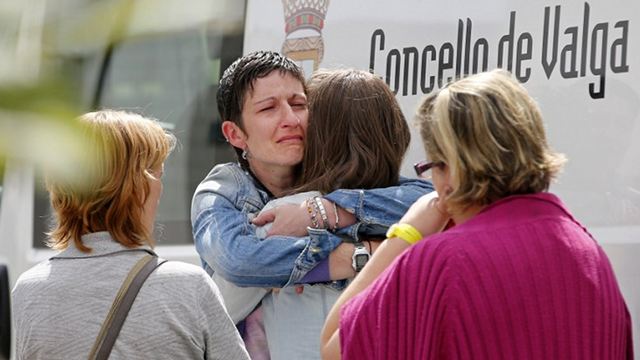SUMMARY
This is AI generated summarization, which may have errors. For context, always refer to the full article.

MADRID, Spain (UPDATED) – Speeding was the main suspect Thursday, July 25, in a rail disaster in Spain that killed 78 people and left more than 140 injured but the reliability of the track security system is also being questioned.
The train flew off the tracks on a curve late Wednesday as it was about to enter Santiago de Compostela station in the northwestern region of Galicia, causing carriages to pile into each other and overturn.
One of the drivers told railway officials by radio shortly after the crash that the train had taken the bend at 190 kilometers (118 miles) an hour, unidentified investigation sources told El Pais newspaper.
“I hope no one died because it will weigh on my conscience,” he reportedly said via the train’s radio moments after the accident as he was trapped in the cab of the train and before he knew about the magnitude of the crash.
A court official told AFP that police would question one of the drivers on Thursday.
The speed limit in the urban zone around the city of Santiago de Compostela is 80 kilometers an hour, said the head of state railway firm Renfe, Julio Gomez-Pomar Rodriguez.
Rodriguez would not speculate on the possible causes of the disaster but the Spanish secretary of state for transport said the disaster looks to have been caused by speeding.
“The tragedy that happened in Santiago de Compostela seems to be linked to excessive speed, but we are still waiting on the judicial investigation and the one carried out by the investigating commission from our own ministry,” Rafael Catala told radio station Cadena Ser.
But Inaki Barron, the director of passengers at the International Union of Railways, said “accidents, not just rail accidents, don’t have only one cause but are due to several circumstances.”
“It is very likely that other factors played a role,” he told Spanish public radio.
Renfe said the train had no technical problems and had just passed an inspection on the day of the accident, adding that the cause was unknown.
“What we know is that the train did not have any technical problems, the train had passed an inspection that same morning,” Rodriguez, the head of Renfe, told Cadena Cope radio station.
“To put it in another way, the maintenance record and monitoring of the train was perfect.”
One of deadliest rail disasters
The accident – Spain’s deadliest rail disaster since 1944 – happened on a stretch of high-speed track about four kilometers (2.5 miles) from the station in Santiago de Compostela.
The train was the Alvia model which is able to adapt between high-speed and normal tracks.
Experts raised questions about the speed signaling system of the track.
Since high-speed trains pass on the track it has been equipped with an automatic speed control system called the European Rail Traffic Management System (ERTMS).
“The ERTMS security system was not implemented four kilometers before Santiago de Compostela, unfortunately,” the secretary general of the Spain’s train drivers’ union SEMAF, Juan Jesus Garcia Fraile, told Spanish public radio.
Another security system known as ASFA, which controls mostly speed signals on the track, was in place on this section of the track, he added.
“It is a security system that is a little bit more dependent on the human factor,” said Fraile.
The high-speed rail track linking Ourense, Santiago de Compostela and La Coruna in Galicia is one of Spain’s newest, having been inaugurated in December 2011.
The construction of the high-speed line is not complete as it finishes 4 kilometers before the train station at Santiago de Compostela, becoming a conventional track after that, Fraile said.
“We need to ask those who built it why it was not extended all the way to the station,” he said.
Spain has made massive investments in road and rail links over the past decade and the country has the second-largest high-speed rail network in the world which spans 3,100 kilometers. Only China’s is larger. – Rappler.com
Add a comment
How does this make you feel?
There are no comments yet. Add your comment to start the conversation.